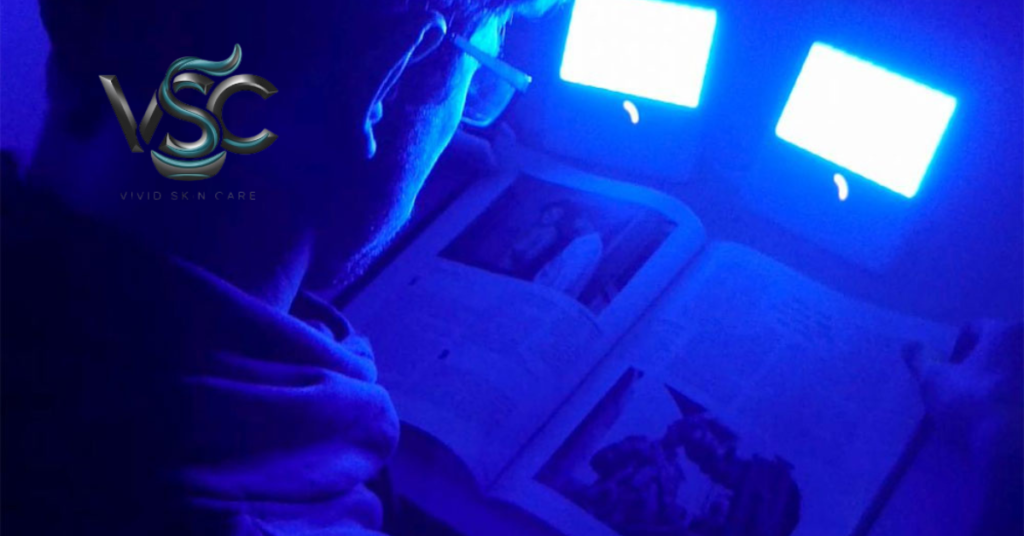Introduction
Blue light exposure is a growing concern in the digital age, where screens dominate our daily lives. Bryan Johnson, a visionary entrepreneur and biohacker, has shed light on the detrimental effects of blue light on sleep quality and overall health. His strategies to counteract these effects offer a practical guide for anyone looking to improve their sleep patterns and reclaim restorative rest.
This article delves into the science behind blue light, its impact on circadian rhythm, and how Bryan Johnson incorporates blue light management into his sleep optimisation routine.
The Science Behind Blue Light
What Is Blue Light?
Blue light is visible light with a short wavelength and high energy, commonly emitted by digital devices like smartphones, computers, and LED lighting. While natural blue light from the sun is essential for regulating our sleep-wake cycle, excessive exposure to artificial sources can disrupt this balance.
How Blue Light Affects Sleep
- Suppression of Melatonin: Blue light exposure in the evening delays the release of melatonin, the hormone that signals your body to sleep.
- Shift in Circadian Rhythm: Prolonged exposure can shift your internal clock, leading to difficulty falling asleep or staying asleep.
- Eye Strain and Fatigue: Overexposure causes digital eye strain, contributing to discomfort and tiredness.
Bryan Johnson’s Approach to Managing Blue Light
Bryan Johnson has incorporated cutting-edge techniques into his health regimen to mitigate the impact of blue light exposure. Here are the key steps he recommends:
1. Blue Light Blocking Glasses
Johnson uses specialized glasses that filter out blue wavelengths.
- When to Wear Them: In the evening, especially during screen time.
- Benefits: Helps the body produce melatonin naturally, improving sleep onset.
2. Technology Settings
Many devices offer features to reduce blue light emissions.
- Night Mode: Activate the night shift or similar settings on your devices to reduce blue light.
- Screen Dimming: Lower brightness levels on screens in dim environments.
3. Limit Screen Time Before Bed
Bryan Johnson suggests avoiding screens at least 1-2 hours before bedtime.
- Alternative Activities: Read a physical book, meditate, or engage in relaxing offline activities.
- Benefits: Reduces stimulation and prepares the brain for sleep.
Creating a Blue Light-Free Sleep Environment
Johnson emphasizes the importance of an optimal sleep environment:
- Dim Lighting: Replace bright LEDs with warmer, dimmer lighting in the bedroom.
- Use Blackout Curtains: Block any external light to maintain a dark sleeping space.
- No Electronics: Keep devices out of the bedroom to eliminate blue light distractions.
Tools and Technologies Bryan Johnson Recommends
1. Smart Home Lighting Systems
Johnson incorporates smart lighting that mimics natural light patterns. These systems gradually shift from bright to warm tones as bedtime approaches.
2. Light Therapy Devices
During the day, Bryan uses light therapy devices to regulate his circadian rhythm, ensuring adequate exposure to healthy light in the morning.
3. Sleep Tracking Wearables
He monitors his sleep quality with wearables to evaluate the impact of blue light management. This data-driven approach helps refine his routine for better results.
The Broader Health Implications
Beyond Sleep
Excessive blue light exposure doesn’t just harm sleep; it also affects overall health. Studies suggest it may contribute to:
- Eye Health Issues: Prolonged exposure increases the risk of macular degeneration.
- Mental Health Challenges: Poor sleep due to blue light can heighten stress and anxiety.
- Cognitive Decline: Lack of quality sleep impairs memory and decision-making.
Johnson’s Focus on Holistic Health
For Bryan Johnson, managing blue light is just one part of his comprehensive health strategy. By combining blue light management with proper nutrition, exercise, and stress reduction techniques, he strives for peak performance and longevity.
Practical Tips for Reducing Blue Light Exposure
Here’s how you can adopt Bryan Johnson’s strategies to improve your sleep:
- Invest in Blue Light Glasses: Choose quality glasses with certified blue light filters.
- Set Device Curfews: Turn off screens at least an hour before bed.
- Optimize Lighting: Use warm, dim lights in the evening and bright, natural light during the day.
- Educate Yourself: Learn about the settings and tools available on your devices to reduce exposure.
- Prioritize Sleep Hygiene: Pair blue light reduction with habits like maintaining a consistent sleep schedule.
Conclusion
Bryan Johnson’s proactive approach to mitigating blue light exposure offers valuable insights for anyone seeking better sleep and improved overall health. By adopting his strategies, you can shield yourself from the adverse effects of blue light while supporting your body’s natural rhythms.

